List of stews
Appearance
This is a list of notable stews. A stew is a combination of solid food ingredients that have been cooked in liquid and served in the resultant gravy. Ingredients in a stew can include any combination of vegetables, such as carrots, potatoes, beans, onions, peppers, tomatoes, etc., and frequently with meat, especially tougher meats suitable for moist, slow cooking, such as beef chuck or round. Poultry, pork, lamb or mutton, sausages, and seafood are also used.
Stews
[edit]| Name | Image | Origin | Traditional protein | Description and distinctive ingredients |
|---|---|---|---|---|
| Ají de gallina | 
|
Peru | Fowl | Peruvian chicken stew |
| Alicot | France | Offal | Stew made with poultry giblets and possibly the head, feet and wing tips | |
| Andrajos | 
|
Spain (Jaén) | Game | Stew of tomatoes, onions, garlic, red pepper, and rabbit, thickened with cake flour |
| Asam pedas | 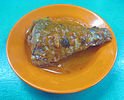
|
Indonesia Malaysia |
Fish | Sour and spicy stew dish made of seafood, typically fish, cooked in tamarind fruit juice, chili, and other spices |
| Balbacua | 
|
Philippines | Beef | Beef stew made from beef and collagen-rich parts of beef stewed for four to six hours in various spices |
| Bamia | 
|
Egypt | Lamb | Stew prepared with okra and lamb as primary ingredients[1][2] |
| Beef bourguignon | 
|
France (Burgundy) |
Beef | Stew made of beef braised in red wine, traditionally red Burgundy,[3] and beef broth, generally flavoured with garlic, onions, and a bouquet garni, with pearl onions and mushrooms |
| Beef Stroganoff | 
|
Russia France |
Beef | Beef Stroganoff or beef Stroganov (Russian: бефстроганов befstróganov) is a Russian dish of sautéed pieces of beef served in a sauce with smetana (sour cream). |
| Bicol express | 
|
Philippines | Pork or beef | Stew made from long chillies, pork or beef, coconut milk, shrimp paste or stockfish, onions, pork, and garlic |
| Bigos | 
|
Poland Ukraine Lithuania |
Pork | Stew that features white cabbage, sauerkraut, various cuts of meat and sausages, often whole or puréed tomatoes, honey, and mushrooms |
| Birnen, Bohnen und Speck | 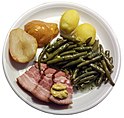
|
Germany | Pork | Typical dish in which pears, beans, and bacon are cooked together |
| Birria | 
|
Mexico | Goat | Spicy meat stew made of pork, goat, lamb, or mutton that is traditionally served on holidays, such as Christmas |
| Blanquette de veau | 
|
France | Veal | Bright veal ragout with mirepoix |
| Blindhuhn | 
|
Germany (Westphalia) |
Pork | A stew of the Westphalian cuisine prepared with beans, vegetables, and bacon |
| Booyah | 
|
United States (Upper Midwest) |
Various | Thick stew popular in the Upper Midwestern United States with meat and vegetables, often prepared communally in large kettles, with several different meats |
| Bosanski lonac | 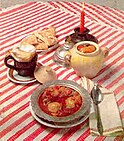
|
Bosnia and Herzegovina | Lamb | Typical Bosnian dish with beef, lamb, cabbage, potatoes, tomatoes, carrots, parsley, garlic, and peppercorns (whole, not ground) |
| Bouillabaisse | 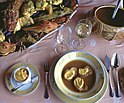
|
France (Marseille) |
Seafood | Bony fish and seafood stew with vegetables and Provençal herbs and spices: The name refers to a "simmering boil", the temperature of cooking the stew. |
| Brongkos | 
|
Indonesia (Yogyakarta and Central Java) |
Beef | Meat (beef or mutton) with beans (black-eyed peas or kidney beans) stew, with boiled egg and spicy soup made of Pangium edule, coconut milk, and other spices |
| Brodetto | 
|
Italy | Fish | Fish stew typical of the Eastern (Adriatic) coast of Italy: It may slightly vary from place to place. In Veneto, it is eaten with polenta. In Abruzzo, tomato sauce is added. It is similar to Croatian brudet. |
| Brudet | 
|
Croatia Montenegro |
Fish | A fish stew that is usually eaten with polenta, similar to Italian brodetto |
| Brunswick stew | 
|
United States (South) |
Game | Tomato-based stew containing various types of lima beans or butter beans, corn, okra, and other vegetables, and one or more types of meat: Most recipes claiming authenticity call for squirrel or rabbit meat, but chicken, pork, and beef are also common ingredients. |
| Trippa alla milanese (Buseca in South America) | Trippa alla milanese.JPG | Italy Argentina Uruguay |
Offal | Italian stew also common in Uruguay and Argentina, similar to Spanish callos, it is made of finely chopped mondongo (beef tripe), potatoes, and legumes such as lentils or chickpeas. |
| Buddha Jumps Over the Wall | 
|
China | Fish | Cantonese variation on shark fin soup |
| Buğu kebabı | Turkey | Lamb | Turkish lamb and vegetable stew with a kebab name | |
| Burgoo | 
|
United States (Midwest and South) |
Game | Traditionally made with wild game, this spicy thick stew is similar to Irish or Mulligan stew, often served with cornbread or corn muffins. Often prepared communally, it is made with several different meats. |
| Cabbage stew | 
|
Central Europe | Vegetarian | Prepared using cabbage as a main ingredient: Pictured is kapuska. |
| Cacciatore | 
|
Italy | Fowl | A stew with braised chicken (pollo alla cacciatora), sometimes with rabbit (coniglio alla cacciatora), tomatoes, onions, herbs, often bell peppers, and sometimes wine. |
| Cacciucco | 
|
Italy | Fish | A fish stew, it is made with several different types of fish and shellfish cooked in wine, tomatoes, and chili pepper, as typical of west-central Italy and especially Livorno. |
| Cachupa | 
|
Cape Verde | Goat | Slow-cooked stew of corn (hominy), beans, and fish or meat (sausage, beef, goat, or chicken) |
| Caldeirada | 
|
Portugal | Seafood | Stew consisting of a large variety of fish, and sometimes shellfish, with potatoes, tomatoes and onions |
| Caldereta de cordero | 
|
Spain | Lamb | Lamb or mutton stew |
| Caldo avá | Paraguay | Offal | Stew made of beef tripes, chitterlings, heart, and matambre | |
| Caldo gallego | 
|
Spain | Pork | Stew made with fatty pork, white beans, and greens (cabbage or spring greens), literally means "Galician broth" |
| Callaloo | 
|
Caribbean West Africa |
Vegetarian | Caribbean dish made of leaf vegetables, amaranth, capsicum, and taro |
| Callos | 
|
Spain | Offal | A stew common across Spain, it is considered traditional to Madrid, where it is referred to as callos a la madrileña. It contains beef tripe and chickpeas, blood sausage, and bell peppers. Chorizo sausage may also be used. |
| Caparrones | 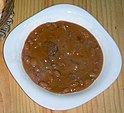
|
Spain (La Rioja) |
Sausage | Stew made of caparrón (a variety of red kidney beans) and a spicy chorizo sausage |
| Caponata | 
|
Italy (Sicily) |
Vegetarian | Vegetable stew from Sicily that consists mainly of aubergine (eggplant) tomato sauce, onions, celery, olives, capers, and Agrodolce. |
| Capra e fagioli | Italy (Liguria) |
Goat | Stew made of goat meat, white wine, and white pigna beans | |
| Carbonada | Argentina, Uruguay | Beef | Traditional Argentinian and Uruguayan sweet-sour beef, squash, and apricot stew, traditionally served inside a squash | |
| Carbonade flamande | 
|
Belgium, France | Beef | Traditional Belgian sweet-sour beef and onion stew made with beer, and seasoned with thyme and bay leaf: Pictured is carbonade flamande with fries and a side of greens. |
| Carne mechada | 
|
Colombia Chile Venezuela[4] |
Beef | Latin American beef stew |
| Cassoulet | 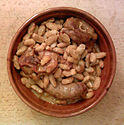
|
France (Languedoc) |
Fowl and sausage | French dish that consists of slow-cooked meat, typically pork sausages, pork, goose, duck, and sometimes mutton, with white haricot beans |
| Cawl | 
|
United Kingdom (Wales) |
Lamb | Lamb stew (beef or hock in Pembrokeshire), which includes vegetables, such as leeks and potatoes, as well as carrots, celery, onion, parsnip, swede, and turnip |
| Chairo | 
|
Bolivia | Beef | Meat and vegetable stew with potato starch (chuños), onions, carrots, potatoes, white corn, beef, and wheat kernels |
| Chakapuli | 
|
Georgia | Lamb | Popular stew with lamb chops or veal, onions, tarragon leaves, cherry plums or tkemali (cherry plum sauce), dry white wine, mixed fresh herbs (parsley, mint, dill, coriander), garlic, and salt |
| Chapea | Dominican Republic | Sausage | Traditional dish from the countryside that consists of cooked red beans with longaniza (Dominican sausage), rice, ripe plantain, and mashed squash used as a thickener | |
| Chicken mull | 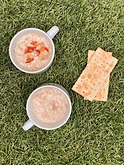
|
United States (South) |
Fowl | A traditional dish from North Carolina and Georgia, it consists of parboiled whole chicken in a cream- or milk-based broth with butter, seasoned with salt, white or black pepper, and other ingredients. Traditionally, the stew is served in the late fall and winter, often prepared communally. |
| Chicken pastel | 
|
Philippines | Chicken or pork | Stew or pie made with chicken, sometimes pork, sausages, mushrooms, peas, carrots, potatoes, soy sauce, and various spices in a creamy sauce. |
| Chili con carne | 
|
United States (Texas) |
Beef | A spicy stew that traditionally features chopped or ground beef, chili peppers, and other ingredients. |
| Cholent | 
|
France | Beef, chicken or goose | Slowly simmered Jewish stew of Ashkenazi origin that cooks overnight and is traditionally served at the Shabbat meal. Its main ingredients are meat, onions, potatoes, beans or chickpeas, and barley. It is believed to be derived from the hamin of Sephardic Jews. Similar to the French cassoulet. |
| Chupe Andino | Andes | Game | Refers to various stews and soups that are prepared in Andes Mountains region of South America | |
| Chupín | Uruguay | Fish | Made with any fish of firm meat, usually hake, croaker, or boga, potatoes, tomatoes, and onions, crumbs of marine crackers are usually poured over at the end. | |
| Ciambotta | 
|
Italy | Vegetarian | Typically based on vegetables, but it may have other ingredients, such as meat or fish. The vegetable choices are usually potatoes, eggplant, tomatoes, sweet peppers, chili, onion and herbs. |
| Cioppino | 
|
United States (San Francisco) |
Fish | An Italian-American fish stew, it is traditionally made from the catch of the day, which in the dish's place of origin is typically a combination of Dungeness crab, clams, shrimp, scallops, squid, mussels, and fish. The seafood is then combined with fresh tomatoes in a wine sauce, and served with toasted bread, either sourdough or baguette. |
| Cocido lebaniego | 
|
Spain (Cantabria) |
Pork and offal | Its essential ingredients include chickpeas, potatoes, and collard greens. The rest of the elements are compangu, meat from the pig slaughter, such as bacon (tocino), black pudding (morcilla), chorizo, and ham. Other additional ingredients are beef, especially cecina and bones, and a stuffing made of bread flour, egg, and parsley. |
| Cocido madrileño | 
|
Spain (Madrid) |
Pork | Its main ingredient is the chickpea or garbanzo bean, preferably of its larger variety, also known as kabuli. Vegetables are added, potatoes mainly, but also cabbage, carrots, and turnips. In some cases, green beans, mangold, or cardoon are added. Meats like beef, hen, lard, chorizo, a small block of cured Jamón and morcilla (a type of black pudding) complete the ingredients.
Cocido is commonly served with the ingredient types grouped, and the broth served as first course, with very thin pasta, fideo cabellín added. |
| Cocido montañés | 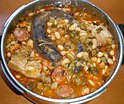
|
Spain (Cantabria) |
Pork and offal | Also known as highlander stew. It is made with two vegetal ingredients, dried large white beans and collard greens (berza). The rest of the elements of this recipe are known as compangu, meat ingredients from the pig slaughter: bacon (tocino), pork ribs (costilla), black pudding (morcilla) with rice, and chorizo. |
| Compote | Game | Game stew made for example from rabbit, partridge, or pigeon | ||
| Coq au vin | 
|
France | Fowl | French braise of chicken cooked with wine, lardons, mushrooms, and optionally garlic |
| Cotriade | 
|
France (Brittany) |
Fish | Breton-style stew made with potatoes and many kinds of fish, but without shellfish |
| Cozido/Cocido | 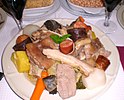
|
Portugal Spain |
Various | Stew made with different meats and vegetables; numerous regional variations exist throughout Portugal and Spain |
| Cream stew | 
|
Japan | Various | Cream stew is a Japanese Yōshoku dish consisting of meat, usually chicken or pork, and mixed vegetables, onion, carrot, potato and cabbage, cooked in thick white roux. |
| Daube | 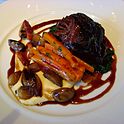
|
France (Provence) |
Beef | Classic Provençal stew made with inexpensive beef braised in wine, vegetables, garlic, and herbes de Provence, and traditionally cooked in a daubière, a braising pan. |
| Dillegrout | United Kingdom (England) |
Fowl | Chicken pottage made with almond milk, sugar, and spices traditionally presented at coronations of English monarchs by the lord of the manor of Addington.[5] | |
| Dimlama | 
|
Uzbekistan | Lamb | Stew made with various combinations of meat, potatoes, onions, vegetables, and sometimes fruits. |
| Dinuguan | 
|
Philippines | Offal | Filipino savory stew of meat or offal (typically lungs, kidneys, intestines, ears, heart and snout) simmered in a rich, spicy dark gravy of pig blood, garlic, chili (most often siling mahaba), and vinegar. |
| Drokpa Katsa | Tibet | Offal | Stewed tripe, with curry, fennel, monosodium glutamate, and salt. | |
| Escudella i carn d'olla | 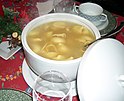
|
Spain (Catalonia) |
Sausage | Stew that contains a pilota, a very big meatball spiced with garlic and parsley. It contains vegetables, such as celery, cabbage, carrots, etc. depending on the season. Bones, sausages called botifarras, and other types of meat can be used. |
| Étouffée | 
|
United States (Louisiana) |
Seafood | Seafood dish of the Creole cuisine of Louisiana that is usually served over rice. Literally means "smothered" in French. |
| Fabada Asturiana | 
|
Spain (Asturias) |
Pork | Fabada is made with dried large white beans (fabes de la Granja, soaked overnight before use), shoulder of pork (Lacón Gallego) or bacon (tocino), black pudding (morcilla), chorizo, and often saffron (azafrán). Some recipes also call for longaniza. |
| Fabes con almejas | 
|
Spain (Asturias) |
Seafood | Clam stew that calls for small clams, fava beans, onions, garlic, salt, saffron, bay leaves, olive oil, parsley, bread crumbs and sometimes sweet paprika. |
| Fahsa | 
|
Yemen | Lamb | Stew made of lamb cutlets with lamb broth. Spices and holba (fenugreek) are added after cooking. |
| Fårikål | 
|
Norway | Lamb | Traditional dish, consisting of pieces of mutton with bone, cabbage, whole black pepper and optionally a little wheat flour, cooked for several hours in a casserole, traditionally served with potatoes boiled in their skins. Literally means "mutton in cabbage". |
| Fasole cu cârnaţi | 
|
Romania | Sausage | Dish consisting of baked beans, sausages or smoked ham. |
| Feijoada | 
|
Brazil Portugal Uruguay |
Beef | Stew of beans with beef or pork, and may include other vegetables. |
| Fesenjān | 
|
Iran | Fowl | Thick, tart stew made from pomegranate juice and ground walnuts; traditionally made with poultry, but variants using balls of ground meat, ghormeh cut lamb, fish, or no meat at all are not unusual. |
| Flaki | 
|
Poland | Beef | Meat stew with common ingredients, including beef tripe, beef, bay leaf, parsley, carrots, beef broth, and spices to taste, including salt, black pepper, nutmeg, sweet paprika, and marjoram. |
| Főzelék | 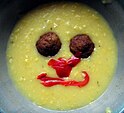
|
Hungary | Vegetarian | Very thick vegetable soup, so it may be considered a stew. Sometimes served with meatballs and often eaten as a side dish. |
| Fricot | 
|
Canada (Acadia) |
Various | Consists of potatoes, onions, and whatever meat was available, cooked in a stew and topped with dumplings. The common meats used are chicken (fricot au poulet), clams (fricot aux coques), rabbit (fricot au lapin des bois), beef, or pork. |
| Gaisburger Marsch | 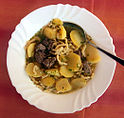
|
Germany (Swabia) |
Beef | Swabian dish made from meat with cooked potatoes and spätzle. |
| Galinhada | 
|
Brazil | Fowl | Stew of rice and chicken. |
| Garbure | 
|
France (Gascony) |
Pork | Stew of ham with cabbage and other vegetables, usually with cheese and stale bread added. |
| Ghapama | 
|
Armenia | Vegetarian | Sweet pumpkin stew, traditionally cooked in the pumpkin shell; does not contain meat. |
| Gheimeh | 
|
Iran | Lamb | Stew consisting of diced lamb or sometimes beef, tomatoes, split peas, onion and dried lime, garnished with golden thinly sliced crispy potatoes. The stew is usually served with white rice. |
| Ghormeh sabzi | 
|
Iran | Vegetarian (but often made with lamb or beef) | Dish that consists of a mixture of sautéed herbs, consisting mainly of parsley, leek, and a smaller amount of fenugreek leaves, where this is usually the dry herb of the mix. |
| Goat water | 
|
Montserrat | Goat | A national dish of Montserrat prepared with goat meat and vegetables. |
| Goulash | 
|
Hungary | Beef | Soup or stew of meat, noodles and vegetables, especially potato, seasoned with paprika and other spices. |
| Guatitas | 
|
Chile Ecuador |
Offal | Stew whose main ingredient is pieces of tripe. |
| Guiso carrero | Argentina Uruguay |
Beef | Traditional stew made with beef, chorizo, white beans, chickpeas, potato, sweet potato, squash, carrots, onions and noodles, condimented with adobo, a species mix of oreganon, thyme, cumin, paprika and chili. | |
| Gumbo | 
|
United States (Louisiana) |
Seafood & sausage | Stew or soup that consists primarily of a strongly-flavored stock, with meat or shellfish, a thickener, and the vegetable "holy trinity" of celery, bell peppers, and onions. |
| Güveç | 
|
Turkey | Lamb | Vegetable and meat stew made with mutton or veal and common to Balkan countries. |
| Guyana Pepperpot | 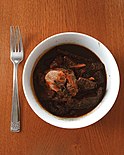
|
Guyana | Various | Stewed meat dish, strongly flavored with cinnamon, hot chili peppers, and cassareep, a special sauce made from the cassava root. Beef, pork, and mutton are the most popular meats used. Chicken is also used. |
| Hachee | 
|
Netherlands | Various | Traditional Dutch stew based on diced meat, fish or poultry, and vegetables. |
| Hamin | 
|
Iberia | Lamb, beef, or chicken | Traditional Sephardic Jewish Sabbath stew cooked overnight. Made from whole grains, meat, chickpeas or beans, and onion. Also known as dafina. |
| Hasenpfeffer | 
|
Germany | Game | Traditional German stew made from marinated rabbit or hare, cut into stewing-meat sized pieces and braised with onions and wine, in a marinade thickened with the animal's blood. |
| Hochepot | 
|
France | Beef | Flemish stew made with oxtail, shoulder of mutton, salted bacon, and vegetables. |
| Hoosh | United States | Beef (dried) | Thick stew made from pemmican (a mix of dried meat, fat, and cereal) or other meat, thickener such as ground biscuits, and water. Used on expeditions to frozen polar regions. | |
| Hot pot | 
|
China Taiwan Mongolia |
Various | Stew made with a variety of raw meats, seafood, vegetables, noodles, dumplings, etc., all cooked at the table in a simmering hot pot of broth. |
| Irish stew | 
|
Ireland | Lamb | Traditional stew made from lamb or mutton, as well as potatoes, carrots, onions, and parsley. |
| Islim or patlıcan kebabı | 
|
Turkey | Lamb | Traditional stew made from veal or mutton and eggplants, also having tomatoes and green peppers. |
| Istrian stew | 
|
Croatia | Pork | Stew whose main ingredients are beans, sauerkraut, potatoes, bacon, and spare ribs; the main seasoning is garlic. |
| Jjigae | 
|
Korea | Various | Stew prepared using meat, seafood or vegetables in a broth seasoned with gochujang (red chilli paste), doenjang (soy bean paste), ganjang (soy sauce) or saeu-jeot (salted and fermented shrimp).[6] |
| Jugged hare | 
|
France United Kingdom |
Game | Stew prepared using rabbit or hare as a main ingredient. |
| Karhi | 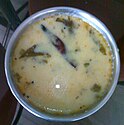
|
Indian Subcontinent | Vegetarian | Spicy stew with a thick gravy based on chickpea flour (called besan in Urdu / Hindi). Contains vegetable fritters called pakoras, to which sour yoghurt is added to give it a little sour taste. |
| Kadyos, baboy, kag langka | Philippines | Pork | Pigeon peas, ham hock, and jackfruit soured with batuan fruits (Garcinia binucao)[7] | |
| Kadyos, manok, kag ubad | Philippines | Fowl | Pigeon peas, chicken, and banana pith[8][9] | |
| Kaldereta | 
|
Philippines | Goat | Dish whose common ingredients are goat shoulders with tomato paste and liver spread. |
| Kalops | 
|
Sweden | Beef | Swedish stew made of beef, onion, allspice, bay leaves and sometimes carrots. Often eaten with beetroot and potatoes. |
| Kamounia | 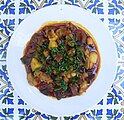
|
Sudan Egypt Tunisia |
Beef | Beef and liver stew prepared with cumin |
| Kapuska | 
|
Turkey | Veal | Cabbage and veal stew. |
| Kare-kare | 
|
Philippines | Beef | Popular stew made from a peanut-based sauce with a variety of vegetables, stewed oxtail, beef, and occasionally offal or tripe. Meat variants may include goat meat or (rarely) chicken. |
| Karelian hot pot | 
|
Finland | Beef and pork | Traditionally made of a combination of pork and beef, but lamb can also be used. The hot pot is usually seasoned with black peppercorns and salt. Other seasonings such as allspice and bay leaf may be used too. Common vegetables such as carrot, onion, and root vegetables are acceptable additions to the stew. |
| Khoresh karafs | 
|
Iran | Various | A celery stew, traditionally made with lamb (but various proteins can be used, including vegan versions).[10][11] |
| Kig ha farz | 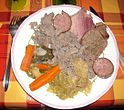
|
France (Brittany) |
Various | Stew consisting of various meats (hock, beef and lamb) simmered in a broth with carrots, potatoes, cabbage and a large buckwheat flour based dumpling. Literally means "meat and stuffing" in Breton. Known mainly in Finisterre. |
| Korma | 
|
India Pakistan Bangladesh |
Various | Meat and/or vegetables is seared, then braised with stock or yogurt kept below curdling temperature with a mixture of spices, including ground coriander, cumin, and Indian bay. Traditionally cooked in a pot set over a very low fire, with coals on the lid. A korma can be mildly spiced or fiery, and may use lamb, beef, chicken, fish. Some kormas combine meat and vegetables such as spinach or cauliflower. |
| Kuru fasulye | 
|
Turkey | Lamb | Stew consisting of dry beans, generally with meat (veal or mutton) and pastırma or sucuk in its broth, with tomato paste. Pictured here is the vegetarian variant. |
| Kuurdak | 
|
Central Asia | Goat | Stewed meat dish made with onion, animal fat, vegetable oil, lamb or mutton.[12] |
| Lancashire hotpot | 
|
United Kingdom (England) |
Lamb | Dish made traditionally from lamb or mutton, and onion topped with sliced potatoes, left to bake in the oven all day in a heavy pot and on a low heat. |
| Läskisoosi | 
|
Finland | Pork | Pork chops grilled in butter with onions and flour, stirred in water with salt and pepper. |
| Lecsó | 
|
Hungary Czech Republic |
Vegetarian | Thick vegetable stew which features peppers, tomato, onion, lard, salt, sugar and ground paprika as a base recipe. |
| Linat-an | Philippines | Pork | Pork stew or soup from the Visayas and Mindanao islands of the Philippines that characteristically uses pork ribs, or other bony cuts of pork, simmered until very tender, lemongrass (tanglad), string beans, starchy ingredients for a thicker soup (usually taro), and various other vegetables. | |
| Lobby | England (North Staffordshire) | Corned beef | Stew or casserole made from corned beef or sometimes chicken, potatoes, carrots, peas, and onion. | |
| Lobster stew | 
|
Spain (Menorca) |
Seafood | Stew made from lobster, which is added to a sofrito with onion, tomato, garlic and parsley; then boiled, and is eaten with thin slices of bread. |
| Locro | 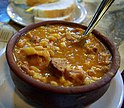
|
Argentina Bolivia Chile Ecuador Peru |
Beef | Hearty thick stew whose main ingredients are corn, some form of meat, usually beef, pork, and chorizo, but sometimes beef jerky or cheese, and vegetables. Other ingredients vary widely, and typically include onion, beans, potato, squash or pumpkin. |
| Lunggoi Katsa | Tibet | Offal | Dish consisting of stewed sheep's head, with curry, fennel, monosodium glutamate, and salt. | |
| Maafe | 
|
West Africa | Various | Stew that is made from lamb, beef, or chicken, cooked with a sauce based on tomatoes and groundnuts (peanuts). |
| Maconochie | United Kingdom (England) |
Beef | Stew of sliced turnips and carrots in a thin soup that was especially made by the "Maconochie Company" for soldiers during World War I | |
| Mazamorra | 
|
Latin America Portugal Spain |
Milk | Sweet stew prepared with corn (maize) as a primary ingredient. |
| Mechado | 
|
Philippines | Beef | A stew traditionally made with larded beef, but now also made with leaner cuts. Marinating in soy sauce and calamansi juice give it a Filipino flavor. |
| Mjave lobio | 
|
Georgia | Vegetarian | Dish of stewed beans, tomatoes and onion. |
| Moambe | 
|
Central Africa | Fowl | Dish prepared with a sauce usually made from the pericarp (not the seeds) of palm nuts, the fruit of the African oil palm. |
| Mocotó | 
|
Brazil Portugal |
Offal | Dish made from cow's feet, stewed with beans and vegetables. |
| Molagoottal | India | Vegetarian | South Indian stew with coconut and lentils as a base. | |
| Moqueca | 
|
Brazil | Fish | Stew based on salt water fish, tomatoes, onions, garlic and coriander. |
| Mulligan stew | United States | Various | Dish similar to Irish stew, Brunswick stew, or burgoo, as improvised by American hobos from available or scavenged ingredients, such as squirrel or opossum. | |
| Navarin | 
|
France | Lamb | French ragoût (stew) of lamb or mutton. Often, vegetables are added. |
| Ndolé | 
|
Cameroon | Fish | National dish of Cameroon, a stew of nuts, ndoleh (bitter leaves indigenous to West Africa), and fish or ground beef. |
| Nikujaga | 
|
Japan | Beef | Japanese dish of meat, potatoes and onion stewed in sweetened soy sauce, sometimes with ito konnyaku and vegetables. |
| Nilaga | 
|
Philippines | Beef | A traditional meat stew or soup from the Philippines made with boiled beef (nilagang baka) or pork (nilagang baboy) with various vegetables. It is typically eaten with white rice and is served with soy sauce, patis (fish sauce), labuyo chilis, and calamansi on the side.[13][14] |
| Oil down | 
|
Grenada | Fowl | Stew made of breadfruit, salted meat, chicken, dumplings, callaloo, and other vegetables, all stewed in coconut milk, herbs, and spices. National dish of Grenada, but also popular in Trinidad and Tobago, with hot peppers and no dumplings. |
| Olla podrida | 
|
Spain | Pork | Spanish stew made from pork and beans and an inconsistent, wide variety of other meats and vegetables, often including chickpeas, depending on the recipe used. |
| Ollada | Spain (Valencia) |
Sausage | Stew based on boiling vegetables and meat in a casserole. | |
| Ostrich stew | South Africa | Fowl | Ostrich stew is a stew prepared using ostrich meat as a primary ingredient. Can include vegetables such as onion, celery and carrot, tomatoes, soup stock and wine. | |
| Ostropel | 
|
Romania | Fowl | Stew that is primarily made from chicken mixed with a thick tomato sauce. |
| Oyster stew | 
|
United States | Seafood | Stew made from oysters with milk and cream |
| Paya | 
|
Pakistan India |
Goat | Stew made with alliums, ginger, spices, and goat or sheep trotters. Coveted for its spicy and fatty broth which is rich in gelatin and animal fat, both rendered from the trotter bones and joints. It is preferred as breakfast with Naan bread. |
| Paila marina | 
|
Chile | Seafood | Typical stew that is usually made of a shellfish stock containing different kinds of cooked shellfish and fish. These are complemented with a variety of herbs and spices such as garlic, cilantro, and onion. |
| Palaver sauce | 
|
West Africa | Various | Stew popular in Western Africa that has many regional varieties and may contain beef, fish, shrimp, pepitas, cassava, taro (cocoyam) leaves, and palm oil. It is served with boiled rice, potatoes, garri, fufu, or yams. |
| Paomo | 
|
China | Lamb | Stew of chopped-up baked unleavened bread cooked in lamb broth and served with lamb meat. It is often eaten with pickled garlic and chilli sauce. |
| Pasulj | 
|
Serbia Montenegro Bosnia Croatia Slovenia |
Sausage | Also known as grah. Bean soup made of white, cranberry or pinto beans, usually prepared with smoked meat such as smoked bacon, sausage, and ham hock. This is a typical winter dish. |
| Philadelphia Pepper Pot | United States (Pennsylvania) | Offal | Thick stew of beef tripe, vegetables and other seasonings; originates in the cuisine of the Pennsylvania Dutch. | |
| Pichelsteiner | 
|
Germany | Various | German stew that consists of several types of meats and vegetables. Common ingredients are beef, pork and mutton, as well as potatoes, carrots and leek. |
| Pinangat | 
|
Philippines | Fish | Filipino stew made of taro leaves, chilli, meat and coconut milk wrapped in gabi leaves and tied securely with coconut leaf. |
| Pindang | 
|
Indonesia Malaysia |
Fish | Stew made of by boiling ingredients, especially fish, in salt and certain spices. |
| Piperade | 
|
France (Basque) |
Vegetarian | Typical Basque dish prepared with onion, green peppers, and tomatoes sautéed and flavored with red Espelette pepper.[15] |
| Pisto | 
|
Spain (Murcia) |
Vegetarian | Stew made of tomatoes, onions, eggplant or courgettes, green and red peppers and olive oil. |
| Pörkölt | 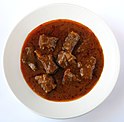
|
Hungary | Pork | Hungarian stew that consists of meat, paprika, and sometimes vegetables, but no potatoes. It should not be confused with goulash, which always contain potatoes and is more like a soup. |
| Pot-au-feu | 
|
France | Beef | French beef stew. Other ingredients may differ from region to region, but commonly various kinds of vegetables are included, such as carrots, turnips, leeks, celery and onions. |
| Potjiekos | 
|
South Africa | Game | South African stew that is usually prepared outdoors. The recipe commonly contains meat, vegetables, starches like rice or potatoes, all slow-cooked with Dutch-Malay spices, the distinctive spicing of South Africa's early culinary melting pot. Other common ingredients include fruits and flour-based products like pasta. |
| Pottage | 
|
United Kingdom | Various | Thick soup or stew made by boiling vegetables, grains, and, if available, meat or fish. Pottage commonly consisted of various ingredients easily available to serfs and peasants, and could be kept over the fire for a period of days, during which time some of it was eaten and more ingredients added. The result was a dish that was slowly but constantly evolving, a "perpetual stew". |
| Pozole | 
|
Mexico | Pork or fowl | Mexican stew with ritual significance made from maize with meat, usually pork, chicken, turkey, or pork rinds, with chili peppers, and other seasonings and garnishes. Vegetarian and vegan versions also exist. |
| Puchero | 
|
South America Spain |
Veal | Stew whose ingredients may vary greatly according to region. Its equivalent may be the Spanish cocido. |
| Qoiri | Tibet | Lamb | Stew of mutton chops, made with flour, shredded wheat, chilli, dry curd cheese, water and salt. | |
| Ragout | 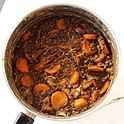
|
France | Various | Refers to a main-dish stew. Ragouts may be prepared with or without meat, a wide variety of vegetables may be incorporated, and they may be more or less heavily spiced and seasoned. Pictured is ragout with lentils. |
| Ratatouille | 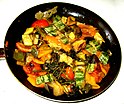
|
France (Provence) |
Vegetarian | Vegetable stew from the Provence that consists mainly of tomatoes with garlic, onions, courgettes (zucchini), aubergine (eggplant), poivron (bell peppers), marjoram and basil, or bay leaf and thyme, or a mix of green herbs, such as herbes de Provence. |
| Red cooked pork | 
|
China Taiwan |
Pork | Braised stew made with soy sauce, Chinese rice wine, caramelized sugar, and spices. Usually made with pork, but other meats, such as beef or chicken are also cooked in this style. |
| Rendang | 
|
Indonesia | Beef | Spicy beef stew braised in a coconut milk and seasoned with a mixture of herbs and spices that has been slow cooked for usually four hours. |
| Rössypottu | 
|
Finland | Pork | Stew made using potatoes (pottu, peruna), some pork and the main ingredient, so-called "rössy" (i.e. blood pudding made of blood, beer, rye flour and some spices). |
| Rogan Josh | 
|
India | Lamb | Aromatic lamb stew native to the Indian subcontinent, which is one of the signature recipes of Kashmiri cuisine. Rogan josh consists of braised lamb chunks cooked with a gravy based on browned onions or shallots, yogurt, garlic, ginger and aromatic spices (cloves, bay leaves, cardamom and cinnamon). |
| Rubaboo | North America | Game | Basic stew or porridge consumed by coureurs des bois and voyageurs (fur traders), as well as Métis people from North America. Traditionally made of peas or corn, or both, with bear or pork grease, and a thickening agent of bread or flour. | |
| Sagamite | North America | Offal | Native-American stew made from hominy or Indian corn. Additional ingredients may include vegetables, wild rice, brown sugar, animal fat, beans, smoked fish or animal brains. | |
| Saksang | 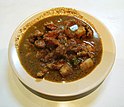
|
Indonesia | Pork | Spicy stew made from minced pork or dog meat (or more rarely, water buffalo meat) stewed in blood, coconut milk, and spices. |
| Saltah | 
|
Yemen | Lamb | Considered the national dish of Yemen, the base is a brown meat stew called maraq, with fenugreek froth and sahawiq or sahowqa, a mixture of chillies, tomatoes, garlic, and herbs ground into a salsa. Common additions are rice, potatoes, scrambled eggs, and vegetables. |
| Sambar | 
|
India | Lentils
Meat |
South Indian stew made with lentils, vegetables and tamarind pulp extract. Famously used as a side dish with idli, dosa, vada, pongal and plain cooked rice. |
| Scouse | 
|
United Kingdom (England) |
Beef | A variation of labskaus. A type of meat or beef stew. |
| Seco | 
|
Ecuador | Lamb | Stewed meat. |
| Sekba | 
|
Indonesia | Offal | Chinese Indonesian pork offals stewed in mild soy sauce-based soup. The stew tastes mildly sweet and salty, made from soy sauce, garlic, and Chinese herbs. |
| Semur | 
|
Indonesia | Beef | Type of meat stew that is processed in thick brown gravy. The main material used in semur gravy is shallots, onions, garlic, kecap manis (sweet soy sauce), nutmeg, and cloves. |
| Shiro | 
|
Eritrea | Vegetarian | Homogeneous stew whose primary ingredient is powdered chickpeas or broad bean meal. |
| Sinigang | 
|
Philippines | Various | Filipino soup or stew characterized by its sour flavor most often associated with tamarind (sampalok). |
| Skirts and kidneys | 
|
Ireland | Pork & offal | Irish stew made from pork and pork kidneys. |
| Sonofabitch stew | United States (West) |
Veal and offal | Cowboy dish consisting of whatever is on hand. Most recipes call for meat and offal from a calf. | |
| Spanish fricco | Germany | Beef | A hearty Westphalian stew prepared primarily using diced beef, potatoes and onions, typically in a cream soup base. | |
| Steak and Kidney | United Kingdom | Beef and offal | Slowly braised beef, traditionally the less tender cuts, and diced ox kidney. Traditionally served with beef suet dumplings which are cooked in the stew. | |
| Stew peas | Jamaica | Various | Jamaican stew prepared using coconut milk, gungo peas (pigeon peas) or red peas (kidney beans), uncured meats and salted meats such as pork and beef. Can also include onion, garlic, scallions, pig tail, herbs, and spices. | |
| Sulu köfte | 
|
Turkey | Sausage | Soup-like stew with köfte meatballs in the dish. |
| Tajine | 
|
North Africa | Lamb | Berber dish from North Africa, named after the special earthenware pot in which it is cooked. It includes different ingredients according to region, but commonly several kinds of vegetables, meats and spices |
| Tas kebap | 
|
Turkey | Veal | Veal or mutton stew with potatoes |
| Tatws Pum Munud | 
|
United Kingdom (Wales) |
Pork | Traditional Welsh stew, made with smoked bacon, stock, potatoes and other vegetables. |
| Tharid | 
|
Arab world | Lamb | Dish made from pieces of bread in a vegetable or meat broth. Pictured is lamb tharid. |
| Tocană | 
|
Romania | Vegetarian | Prepared with tomato, garlic and sweet paprika, it is traditionally consumed with a cornmeal mush called mămăligă. |
| Tomato bredie | 
|
South Africa | Lamb | South African stew with Dutch origin that usually features mutton, which is cooked for a very long time, and includes cinnamon, cardamom, ginger, cloves, and chili as seasonings. |
| Tombet | 
|
Spain (Mallorca) |
Vegetarian | Traditional vegetable stew that contains layers of sliced potatoes, aubergines and red bell peppers previously fried in olive oil. The aubergines and red peppers should not be peeled. The whole is topped with tomato fried with garlic and parsley, and presented in a way that it looks like a pie without a crust. |
| Tuna pot | 
|
Spain, France (Basque) |
Fish | Fish stew that was eaten on tuna fishing boats in the Cantabrian Sea. A simple dish with potatoes, onions, pimientos, and tomatoes. |
| Türlü | 
|
Turkey | Vegetarian | Stew of mixed vegetables stew which may also include meat. The dish is known as tourlou in Greece and as turli tava in North Macedonia |
| Wat (food) | 
|
Ethiopia Eritrea |
Various | Stew or curry which may be prepared with meat, such as chicken, beef, or lamb, or a variety of vegetables, with spice mixtures, such as berbere and niter kibbeh, a seasoned clarified butter. |
| Waterblommetjiebredie | 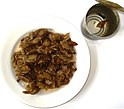
|
South Africa | Lamb | Meat, typically lamb, stewed together with waterblommetjies (Aponogeton distachyos flowers, commonly known as Cape pondweed, Cape hawthorn or Cape asparagus). Literally means "small water flower stew" in Afrikaans. |
| Waterzooi | 
|
Belgium (Flanders) |
Fish | Stew made of fish or chicken, vegetables (carrots, leeks, and potatoes), herbs, eggs, cream, and butter. |
| Zoervleis | Limburg region, Belgium& the Netherlands |
Horse | Traditional dish similar to German sauerbraten which features meat (normally horse meat) that was marinated in vinegar or apple cider. Contrary to what one would expect, it is sweet, as it is served with gingerbread. |
Unsorted
[edit]- Capra e fagioli – Typical dish of the hinterland of Imperia, Liguria
- Ginataang kalabasa – Filipino vegetable stew
- Ginataang labong – Filipino vegetable stew
- Kokotxas – Fish stew from the Basque region
- Kontomire stew – Ghanaian stew
- Or lam – Laotian spicy stew
- Pepián – Guatemalan meat stew
- Waknatoy – Philippine stew
See also
[edit]- Fish stew – includes a list of many fish stews
- List of Azerbaijani soups and stews
- List of fish and seafood soups
- List of Japanese soups and stews
- List of soups
- List of Spanish soups and stews
References
[edit]- ^ Aʿlam, H.; Ramazani, N. (December 15, 1989). "Bāmīā". Encyclopædia Iranica, Vol. III. pp. 656–657.
- ^ Alikhani, Nasim; Gambacorta, Theresa (2023-06-27). Sofreh: A Contemporary Approach to Classic Persian Cuisine: A Cookbook. Knopf Doubleday Publishing Group. pp. 129–130. ISBN 978-0-593-32075-4.
- ^ "Definition of boeuf bourguignon". Oxford University Press. Archived from the original on March 4, 2016. Retrieved 2013-04-18.
- ^ "Carne Mechada". Archived from the original on 2008-05-17. Retrieved 2008-03-23.
- ^ Clarkson, Janet (2010). Soup : a global history. London: Reaktion. pp. 113–114. ISBN 978-1-86189-774-9. OCLC 642290114.
- ^ (in Korean) Jjigae at Doosan Encyclopedia
- ^ "It's Time You Know about Kadios beyond KBL". Pepper.ph. Retrieved 8 February 2021.
- ^ "Manok at Kadyos / Purple Chicken With Pigeon Peas". Market Manila. 21 October 2007. Retrieved 8 February 2021.
- ^ "Kadyos Beans". Ark of Taste. Slow Food Foundation for Biodiversity. Retrieved 8 February 2021.
- ^ Deravian, Naz (2018-09-18). Bottom of the Pot: Persian Recipes and Stories. Flatiron Books. pp. 147–150. ISBN 978-1-250-19076-5.
- ^ Batmanglij, Najmieh (2021). New Food of Life: Ancient Persian and Modern Iranian Cooking and Ceremonies. p. 308.
- ^ "Kuurdak: How The Kyrgyz Do Meat and Potatoes". Folkways. 11 June 2022.
- ^ "Nilagang Baboy (Boiled Pork and Vegetables)". Casa Veneracion. Retrieved 9 September 2021.
- ^ Cailan, Alvin; Cuerdo, Alexandra (2020). Amboy: Recipes from the Filipino-American Dream. Houghton Mifflin Harcourt. pp. 27–28. ISBN 9781328931733.
- ^ Larousse Gastronomique (1998). Paris: Larousse-Bordas. p. 804. ISBN 2-03-507300-6
